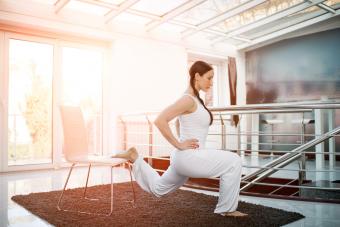
Exercises done in chairs are low impact and can make physical movement much more accessible for people with mobility issues or injuries or those who want to use items at home to get a good workout. Group fitness programs like Silver Sneakers and Zumba Gold offer complete workouts from seated positions, but there are plenty of individual exercises that can be done from a chair to get the body moving and keep active despite limitations.
Chair Exercises for Strength
Not everyone chooses chair exercises as a result of physical limitations; some people want exercises they can do from home, work, or while sitting in a waiting room. A chair can provide a fantastic base for resistance exercises that will help build strength.
Tricep Dips
Tricep dips strengthen the triceps, the area behind the upper arm. It's important to allow your arms to do all the work here - pushing with your legs or thrusting your torso removes the work from your triceps.
- Facing away from the chair, place your hands on the seat with your fingers pointed in the same direction as your toes.
- Extend your legs in front of you with feet on the ground. Your arms will be holding you up at this point. Note that the further out your legs are extended, the more difficult the move will be. Bend your knees if necessary.
- Bend your elbows behind you, "dipping" you down. Your bottom will drop in front of the chair - not into it. This action should take three counts. Keep your chest straight and your spine neutral.
- Hold at the bottom of the movement for a count, then ascend back to the original position in three counts by straightening your arms.
Split Squats
Split squats can help train your legs to get to the point of single-leg squats, which build strength in the quadriceps, hamstrings, calves and glutes. The focus should be on the leg on the ground; the leg on the chair isn't meant to support weight. Keep your chest up throughout this entire movement and make this exercise more difficult by holding weights while squatting.
- Facing away from the chair, place one foot on the seat of the chair. Stand tall with a neutral spine and align the standing leg to where the toes are pointed forward.
- Bend the knee of the standing leg, dropping you down for three counts. Though the weight will be distributed fairly evenly in that foot, focus on pushing the weight toward the heel of the foot as this protects your knee.
- Hold your position at the bottom of the movement, squeezing your glutes, for one count.
- Continuing to squeeze, ascend back to the original standing position. The return to standing tall should take three counts.

Push Ups
A sturdy chair can offer a good base of support for push-ups, allowing you to do push-ups without needing to take your body to the ground. The further away from the chair your feet are, the more difficult the move will be. Lift one leg if you want more challenge. Focus on keeping your body straight like a surfboard and tighten your core muscles by squeezing your glutes.
- Place your hands on the seat of the chair, directly under your shoulders.
- Keeping your back straight, bend your elbows and descend for a count of three.
- Hold your body straight for one count before ascending to your original position in three counts.
- Variations for a chair push up include doing it on your knees (to make it easier), or placing your hands on the ground with your feet in the seat (to make it more difficult).

Squat Press
The chair is used as a weight in this compound movement, which strengthens a variety of muscles including the deltoids, trapezius, quadriceps, hamstrings, and calves. The overhead motion will increase your heart rate to make this a challenging move. Choose a chair that you can lift overhead and note that this advanced move should only be done by those who are familiar with proper squat form already in order to avoid potential injury.
- Stand with feet shoulder-width apart (or your preferred squat stance), focusing your weight into your heels throughout the entire movement. Hold the chair stable above your head with bent elbows.
- Squat for a count of three. At the bottom of the movement, pause for one count to squeeze your glutes before ascending for three counts.
- As you ascend, extend the elbows, pushing the chair up higher above your head. This should involve two movements happening at the same time: the ascension of the squat and the overhead press of the chair.
Accessible Chair Exercises
Exercisers who prefer to stay seated in their chair during their workout session have myriad options for movement. When doing any of these exercises, it's important to engage the core in order to avoid back injury and to keep shoulders and neck relaxed in order to avoid muscle strain.
Chair Boxing
Get some aggression out by doing some boxing from a seated position. Depending on your fitness level, you can add small hand weights to progress this exercise into a more difficult move or place a punching bag in front of you. Keep in mind that the limb extensions required in chair boxing will elevate your heart rate; if you are new to exercising, consult your medical provider to ensure your body's readiness for exertion prior to participating.
Chair Squat
Squats have multiple benefits for building strength, but some people find them a little too challenging to do unassisted. Having a chair as a landing spot can provide much needed support.
- Stand in front of the chair, facing away from the chair. Feet should be shoulder-distance apart.
- Keeping your chest tall and your back straight, bend your knees to descend into the chair. Focus the weight of your body into the heels of your feet and make this a controlled descent - you're not just plopping down into the seat.
- In the same controlled manner, go back into a standing position while squeezing your glutes. Don't allow momentum to do it for you - this should be a slow, controlled movement that engages your muscles.
- For more challenge, lift your arms straight in front of you or overhead.

Dumbbell Exercises
Nearly any exercise done with hand weights can be done from a chair. Keep your core engaged throughout the movements. If you're not ready for weight, go through these movements without dumbbells and instead focus on squeezing your muscles. Take care to not hold your breath while doing these. Options include, but are not limited to:
- Bicep curls: With arms extended and palms up, grasp the dumbbells in your hands. Squeezing your biceps, curl your arm into a flexion by bringing your hands up toward your shoulders. Extend back to the original position and repeat.
- Frontal raises: With arms extended in front of you with palms down, grasp the dumbbells in your hands. Slowly raise the arms upward to shoulder height and lower back down, keeping your arms fully extended and straight throughout.
- Lateral raises: With arms to your side and palms down, grasp the dumbbells in your hands. Slowly lift each arm to the side (right arm lifts right, left arm lifts left), keeping the arms straight and not lifting beyond shoulder height. This should be slow and controlled.
- Shoulder press: With arms at shoulder height, elbows bent, and palms facing forward, grasp the dumbbells and straighten the arms, pushing the weight overhead. As you return to the original position, focus on squeezing the shoulder blades together.

Stretching Chair Exercises
People who spend a great deal of time in a seated position daily are putting more strain on their bodies than they may realize. Some quick stretches from a seated position can help relieve some of the pressure from constant forward flexion.
Neck Stretch
To relieve some of the pressure on your neck, try the following:
- Sit up straight.
- Slowly lean your head toward your left shoulder as far as you can, keeping your face forward, feeling the stretch along your neck.
- Bring your head back to an upright position.
- Now lean your head toward your right shoulder as far as you can.
- Bring your head back to the starting position.

Shoulder Stretch
Many people feel stiffness in their shoulders and backs from hunching over their desks all day. You should take breaks and make sure your posture is good to help prevent that. You can also perform this shoulder chair stretch:
- Sit straight and relax your shoulders.
- Raise your shoulders and rotate them backward, keeping your arms relaxed at your sides.
- Now rotate your shoulders back.

Back/Hamstring Stretch
Suffering from back pain doesn't have to be inevitable. By engaging in regular stretching, even when done from the comfort of a chair, you may be able to prevent having the back problems that so many people complain about. Try this simple stretch:
- Sit upright, back straight.
- Lean over to reach your toes or the right with leg outstretched. If you can't reach your toes, just go as far as you can.
- Slowly return to your original position before repeating on the left.

Daily Fitness
Just because you're tied to a desk all day doesn't mean you can't fit in some exercise. Chair exercises are also good for people who need to ease into working out, whether they have health issues or need to proceed slowly based on a doctor's advice. Whether you're dancing along to music in your chair or lifting weights, you're getting beneficial exercise to help your body build strength and stamina.







